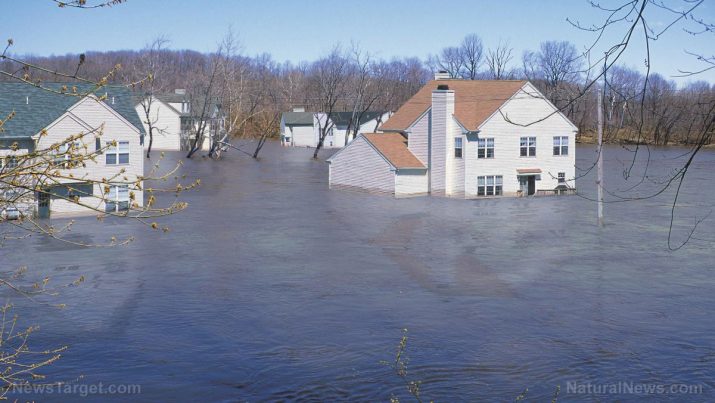Prepping basics: Flood safety tips and how to cache your survival supplies
Monday, November 04, 2019 by Zoey Sky
http://www.bugout.news/2019-11-04-flood-safety-how-to-cache-survival-supplies.html

Every prepper covers both common and uncommon scenarios in their emergency preparedness plans, from natural disasters to life after a nuclear attack. If you live in areas prone to flooding, get your preps ready, so your family can stay safe when the rainy season begins. (h/t to Survivopedia.com)
There are different types of floods – from a storm surge after a hurricane to a flash flood. Generally, floods can be grouped into two categories:
- Fast floods – Fast floods cause damage without warning, and they are strong enough to lift entire buildings off their foundations and carry them away. (Related: Which SHTF situation is most likely to actually happen?)
- Slow floods – These floods occur due to rising waters often caused by excessive rain. Water may even rise quickly, but it doesn’t crash into your home like a destructive wave. However, flooding that lasts long enough may undermine foundations and cause sinkholes.
Preparing an escape plan for floods
Flooding can happen almost anywhere, and it makes sense to prepare for it.
Ideally, your bug-out vehicle should be a four-wheel drive and have oversized tires. Prepare bug-out bags (BOBs) for the whole family, then store them in your bug-out car or an easily accessible area in your house.
If you’re living in a flood-prone area, consider getting an inflatable rubber raft that’s at least large enough to carry your entire family.
Flood-proofing your home
If you want to bug in, you need to make your home flood-proof. While this option is harder than bugging out, if you prep before SHTF, you can protect your property from water damage.
First, determine how high the waters are expected to rise in your area. Second, build a barrier around your home to keep the water out. This is usually done with sandbags. Expect at least eight more inches of water to ensure that your home remains flood-proof.
Place sandbags or your water barrier of choice several feet away from your house. This gives you enough space to walk around your home so you can check for leaks in your sandbag barrier.
Don’t stop your flood preps with just the sandbag barrier. Invest in a gas- or electric-powered pump so you can quickly pump out the water from any leaks in your water barrier.
Setting up a survival cache
While preparing for a flood, consider splitting your stockpile into two locations. If SHTF and you can’t bug in at home, you can rest easy knowing that you have supplies at your bug-out location, and vice versa.
This option can be expensive, which is why you need to start saving up before disaster strikes. If you don’t have the budget for a survival retreat, you can set up preps at a rented storage space in a remote town. Build a stockpile and if you save enough money for a bug-out location, move your supplies there.
Start with the list of cache supplies below and add other items as you see fit.
- Basic survival tools (ax, knife, saw, shovel, etc.)
- A camp stove that runs on gasoline (not propane)
- Non-perishable foods
- Cookware
- Long-term water purification system
- Water containers
- Clean water
- Firestarters (lighters, matches, Ferro rods, etc.)
- Large tent
- Air mattresses and sleeping bags
- A cart (for moving supplies)
- Bicycle for transportation
- First aid kit (with a trauma kit)
- Prescription medicines for chronic conditions
- Personal hygiene supplies (shampoo, soap, toilet paper, etc.)
- Firearms and extra ammunition
The list above also accounts for scenarios where your home sustains terrible damage, or you lose your BOB on your way to your survival retreat. Use the supplies in your cache to replenish the items that you use as you head to your bug-out location.
Hide your survival cache in a sealed, sturdy five-gallon bucket buried in a location that only people you trust know about. Have at least two separate sets of landmarks that won’t be damaged by fire or flooding.
Don’t wait until SHTF before you flood-proof your home and set up a cache that you can access as you head to your secure bug-out location.
Sources include:
Tagged Under: Tags: bugout, emergency planning, emergency preparedness, Flooding, homesteading, natural disasters, off grid, preparedness, prepping tips, SHTF, survival cache

